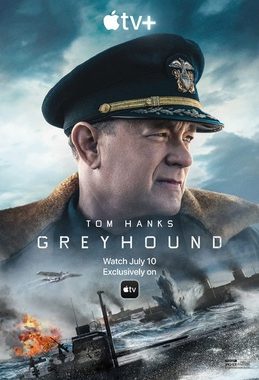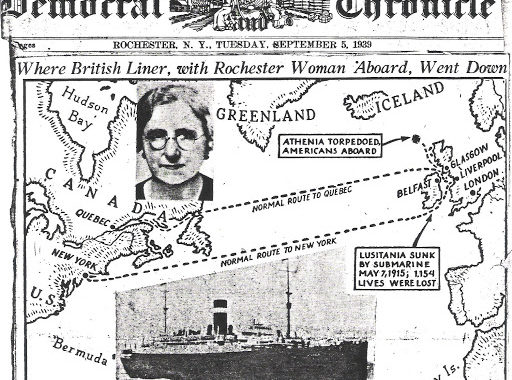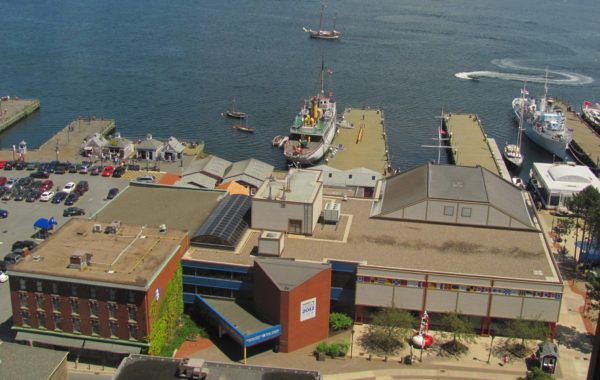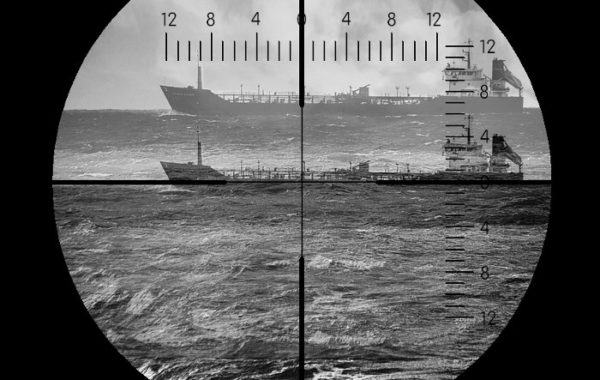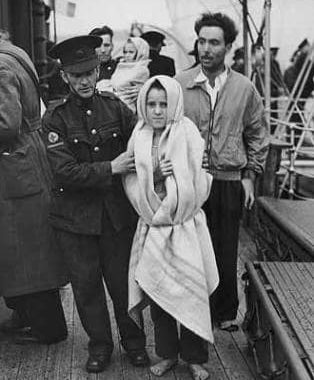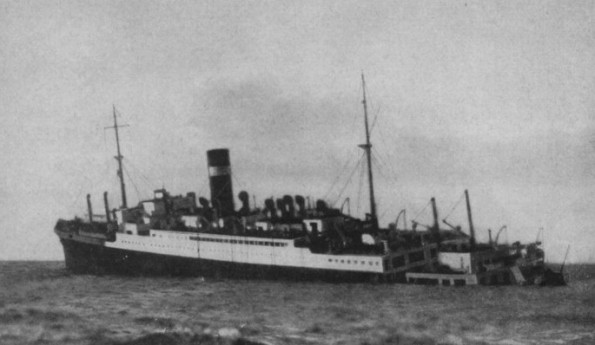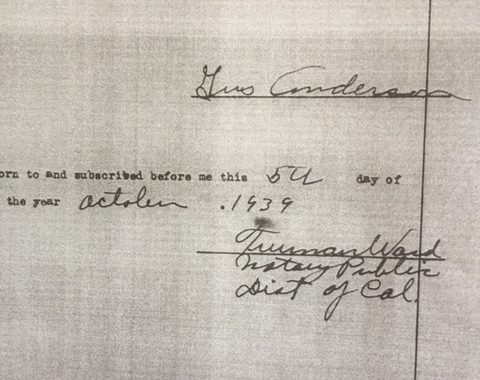It’s time to check back in on the progress of our documentary film, “Athenia’s Last Voyage,” about the sinking of a British passenger ship on the first day of World War II. Since our update early last summer, we’ve completed the film’s script, created a poster and refined our “sizzle reel.”
A sizzle reel is one of many movie-making terms of art that have entered our lexicon. It’s a six- to eight-minute film that helps people see what our documentary is about and how the story will be told, and it is used primarily for raising money (see below).
We are at a crossroads familiar to almost all filmmakers, a junction we never really thought about when we started our project. Simply put, we will need to raise some serious money to complete “Athenia’s Last Voyage.”
For example, we need to search out and acquire the rights to use historic still photos and film clips to bring to life the pre-war era at the end of the 1930’s. These images don’t come cheap. The still photos and film clips that will occupy a third or more of our hour-long documentary could easily cost up to $60,000.
And there are plenty of other expenses. We are also going to need to film reenactments of key scenes, complete animations of ships and several maps, hire a narrator and record the movie’s narration, create and record music and sound effects, and hire an experienced documentary film editor to complete our production. More expenditures are no doubt lurking in the shadows.
So where do we go from here?
We have hired a line producer – Lisa Bruhn. Kay and I had no idea how critical, helpful and encouraging Lisa would prove to be. In a nutshell, the line producer keeps track of the money, develops a realistic budget, handles the accounting and generally makes sure all the financial t’s are crossed and i’s are dotted. Just as Meghan Courtney, our director, is key to the look and feel of the final film, Lisa is key to tracking all the funding, costs, and payouts needed to bring that vision to fruition.
To raise the money for our documentary, we are seeking film-making grants from foundations. Sadly, this pool is shrinking because of Covid-19 concerns. We are encouraging donations and looking for investors through our website: www.atheniaslastvoyage.com, and next spring we will launch a crowdfunding campaign.
So, if you have friends who are interested in World War II and might want to help bring this forgotten story to light, or if you know someone who is looking to invest in an inspiring story of heroism and heartbreak, please direct them to our website. No offer of help is too small.
I thought the most demanding part of making “Athenia’s Last Voyage” would be getting the interviews and writing a script. Now that it is clear the real work has just begun, we are determined as ever to meet these newest demands and tell the story of Athenia’s survivors.
athenia
Battle of the Atlantic, Part 1
The new Tom Hanks movie, “Greyhound,” shines a light on one of the most consequential, yet largely overlooked conflicts of World War II – the Battle of the Atlantic. It was by far the longest continuous combat action of the war, beginning on Sept. 3, 1939, and ending May 8, 1945, the same day Germany surrendered.
Scholars have called the early months of WWII the “Phony War.” England and France had pledged to defend Poland, but took no action when Germany attacked and defeated the Poles in September, 1939. Although the British and French declared war on Germany September 3, both sides avoided major combat actions on the ground or in the air for the eight months following the fall of Poland.
But there was nothing phony about the war being waged in the Atlantic Ocean during that same period. Readers of this blog know the first shot fired in the Battle of the Atlantic was the torpedo that struck the British passenger ship Athenia less than nine hours after Britain and Germany declared war.
The battle was fought over shipping tonnage. Following the fall of France in June, 1940, the British were left to fight on alone against the Nazis. An island nation, Great Britain required a million tons of food and supplies every week in order to sustain its citizens and its war effort. German naval and air forces set out to interrupt that flow of supplies, and by the end of September they had sunk nearly 40 British merchant ships.
Clearly, such losses would be unsustainable over any length of time. For this reason, British Prime Minister Winston Churchill, writing later in his history of the war, said the only thing that frightened him during the war was “the U-boat peril.”
In coming months we will explore more about the Battle of the Atlantic, from the convoy system to U-boat wolfpacks, and the back-and-forth evolution of technology and tactics as both sides sought advantage on this expansive “battleground.”.
From Page to Screen, Part 1
Note: This is the first of several occasional blogs about our documentary project, “Athenia’s Last Voyage.”
Not long after Greenleaf Books published my historical novel, Without Warning, in 2017, readers began telling me that the story would make a great movie. When my wife, Kay, and I explored the possibility with a friend’s daughter-in-law (who is in the movie business), she suggested we first make a documentary about the Athenia incident as a way to pique interest in a future feature film.
My goal all along has been to create a wider awareness of the Athenia as a way to honor the memory of my grandmother and so many others who were aboard that ship torpedoed on the first day of World War II. A documentary seemed like an easy next step toward that goal.
Kay and I have been on a steep learning curve ever since. We found a director, Meghan Courtney, eager to take on the project. Last year we filmed interviews with a dozen Athenia survivors and descendants of survivors in Florida and in Halifax, Nova Scotia, where many had come to attend an 80th anniversary commemoration of Athenia’s sinking.
When the dust finally settled, we had more than 180 pages of interview transcripts. It was time to finally write a script for our documentary, using excerpts from the interviews and narration to tell Athenia’s story. That word “story” is the key. To succeed, our script must conform to the basic rules of storytelling. It should enthrall and entertain us from the beginning, to the middle, and all the way through to the end.
We need to engage viewers immediately, with a promise that the story will be well worth the time they spend to watch it. The beginning must quickly establish the documentary’s timeframe and setting, introduce principal characters, and identify what is at stake for the characters.
The beginning is followed by an inciting incident that complicates the characters’ ability to achieve their goal. The incident introduces the middle of the story in which the characters seek again and again to overcome the obstacles that keep them from achieving their goal. This drama builds to a climax, which brings the middle to a close and introduces the ending in which the story comes to a meaningful conclusion.
Good storytellers bring these elements together in ways that seem innovative and unexpected to create memorable novels and screenplays. But these same principles apply to documentary films, with one big exception. In fiction, the storyteller can invent plot twists and characters that serve these basic elements, but a documentarian has to deal with reality. We can’t make up characters or events to suit a plot.
Laying out the bones of our story in a manner that conforms with all the tenets of dramatic storytelling is our next great challenge.
You can follow our progress at our documentary’s website:
Athenia’s 80th Anniversary
At the start of World War II, the passenger ship Athenia was torpedoed by a German submarine and became the first British ship sunk by the Nazis in the war. While Athenia’s story has faded over the intervening decades, people intent on keeping her memory alive will assemble in Halifax, Nova Scotia, on Sept. 3, 2019, to commemorate the 80th anniversary of the sinking.
Athenia was bound for Canada with 1,418 souls aboard, when she was torpedoed by a German U-boat northwest of Ireland. One hundred twelve passengers and crew members died as a result of the attack that shocked the world on the first day of the war. By the end of the war, however, Athenia’s sinking had seemingly been lost in a tangle of Nazi denials and overrun by the scale of the war’s carnage.
Come Sept. 3, Athenia’s memory will be revived when nearly a dozen survivors and descendants of survivors meet in Halifax, the city that welcomed 236 passengers from the ship after they were picked up at sea by an American freighter 80 years ago.
The Maritime Museum of the Atlantic, located on the city’s historic waterfront, will host an evening program devoted to the Athenia. I am honored to be the featured speaker and hope to share the dais with survivors telling their stories of survival. The program is open to the public and will begin at 6:30 p.m. The museum will remain open until 8 p.m.
Eighty years ago, today’s remaining survivors were children traveling with their parents when Athenia sailed into harm’s way. With most now in their mid to late 80s, the gathering presents a rare opportunity to preserve their eye-witness accounts for our documentary film. Our film crew will be on hand for several days to conduct one-on-one interviews with the survivors and descendants about their families’ encounter with history.
Athenia should not be forgotten, nor should the sacrifice of the men, women, and children who died that night in the North Atlantic when their ship was torpedoed. Our documentary is dedicated to preserving their memory and Athenia’s place in history.
The Writing Game
Getting started as an author is a time-consuming and daunting task. When I wrote my historical novel, Without Warning, I learned that researching and writing the first draft, which sometimes felt like pulling teeth, was the easy part.
After editing, revising, and polishing my manuscript to a fine sheen, I conducted a lengthy search for a publisher to deliver my novel to readers in print and electronic form. When River Grove Books (a division of Greenleaf Book Group) published Without Warning, I discovered the most demanding part of my journey still lay ahead: selling my book to the public. That/s right, most authors become the main sales representative for their books. Here is why.
On average, more than 10,000 new book titles are published every week in America. Last year the total number of books published topped 1 million for the first time. Publishers simply do not have the resources to launch advertising campaigns on behalf of every one of their new titles. “A”-list authors get that treatment because they’ve earned it. It’s up to the rest of us to somehow make a lasting impression of our own in this crowded market.
Fortunately, the folks at Greenleaf offered plenty of ideas for me to pursue on the Internet, making sure I established a presence with author’s pages on Amazon, Facebook, and Goodreads. A year before my novel’s publication I established a website and began a regular blog. My wife and I set up a book launch event at our local library and speaking engagements up and down the West Coast and Florida to tell the story of my novel’s central event, the torpedoing of the British passenger ship Athenia at the beginning of World War II.
We are not marketing experts. Some of these efforts have been hits and some have been misses. As I indicated in my last blog, the latest sales figures show our efforts sold nearly 400 books in nearly two years. Not bad, when you realize the average sales for each book published in the U.S. is 250 copies.
You can imagine how thrilled we were with two recent developments that were quite unexpected. First, in early June, Without Warning won the San Diego Book Award for historical fiction.
That same month, I received word from my publisher that Barnes & Noble had selected Without Warning to launch its new program, called “Digital Deals.” For one day only, June 29, B&N made electronic copies of my novel available on its Nook e-reader for a purchase price of $0.99. When the dust settled, we learned 1,220 e-books were sold through the promotion. What a thrill to be chosen by B&N for this promotion and to see my novel triple its reach in one day.
It is most gratifying to gain all this exposure now, as we approach the 80th anniversary of the start of WWII and Athenia’s sinking. I’ll have more about a big anniversary event planned for Halifax, Nova Scotia, in my next blog.
Why Don’t We Remember Athenia, Part 5
In recent blogs we explored reasons why the German submarine attack that sank the British passenger ship Athenia in the first day of World War II is largely forgotten today. The facts that more than 90 percent of the ship’s passengers and crew survived, that the Nazi government denied responsibility for the attack, and that the death of 30 Americans aboard Athenia did not bring the U.S. into the war, were all seen as contributing to this historical oversight. In today’s blog we continue our exploration with a look at the rules of war.
Press accounts of the Sept. 3, 1939, attack all expressed shock that it had come “without warning.” Today such a reference sounds quaint and naïve, but in 1939 the rules of war – agreed to under international treaties – required submarines to warn certain prospective victims of their intention to attack.
During World War I, German submarines, or U-boats, proved to be such a devastating weapon that following the war, there was talk of outlawing submarines altogether. Negotiators ultimately agreed submarines could be retained as weapons of war so long as conditions were placed on their use.
These conditions were established in 1930 and reinforced in the 1936 London Submarine Protocol, which set out rules for the conduct of submarines in future wars. Enemy warships and merchant ships sailing under escort could be attacked without restriction. But submarines could not attack unarmed, unescorted merchant ships without first giving warning, and to do that they had to be on the ocean’s surface. Once a submarine stopped a merchant ship, it could send a boarding party onto the ship, and if any contraband was found in the ship’s hold, the ship could be sunk.
Submarines are most vulnerable while they are surfaced, so the protocol’s requirements were totally impractical from a tactical standpoint. Nevertheless, 35 nations, including Germany, signed the 1936 London Submarine Protocol. For the three years following its adoption, however, there had not been a major maritime conflict to test its effectiveness.
When Athenia was sunk by a U-boat without any warning, the world feared Germany was returning to the practice of unrestricted submarine warfare that it followed in World War I.
The Nazi U-boat captain who sank Athenia told his superiors he thought he had attacked a British armed merchant cruiser, a legitimate wartime target. He only discovered his mistake after coming to the surface to observe the sinking ship. Indeed, he continued his war patrol and sank two more British merchant ships while scrupulously following the protocol rules.
But by the end of September 1939, Hitler issued several conditions under which his U-boats could ignore the protocol’s restrictions and attack merchant ships without warning. These conditions applied if merchant ships were blacked out, used their radios to report German naval positions, or were obviously armed.
The practical effect of the Führer’s order was to sanction unrestricted U-boat warfare. Within a month, U-boat attacks on merchant ships without giving warning became commonplace, which prompted all others to abandon the London protocol. Once the world’s navies adopted the tactics of unrestricted submarine warfare, the shock of Athenia having been sunk without warning quickly faded.
Next month: War’s utter devastation
Why Don’t We Remember Athenia? Part 3
Throughout World War II, Germany’s Nazi government denied responsibility for sinking the British passenger ship Athenia on the first day of the war. Their denial initially hinged on the fact that no U-boat had reported any action at the time and place where Athenia had been sunk (see blog, Jan. 1, 2019).
Even after the commander of the U-boat that torpedoed Athenia, Fritz-Julius Lemp, returned two weeks later to his base in Germany and admitted his mistake, the denials continued. German Chancellor Adolf Hitler is reported to have made the decision to continue the lie rather than reverse the denials of the previous two weeks.
While few outside of Germany believed the Nazi position, the continued denials raised vague concerns in some people’s minds that perhaps their might have been some other reason for the sinking.
In 1946, as prosecutors prepared for the war crimes trials at Nuremberg following World War II, they discovered discrepancies in the war diary (logbook) of U-30, the German submarine whose combat patrol zone included the location where Athenia was attacked. The first two pages were a different quality paper than the rest of the book. On these pages the months were recorded in Arabic numerals, while Roman numerals were used for the months in the rest of the book. Also, Lemp’s signature was an obvious forgery. The new pages showed U-30 nearly 100 miles from the spot where Athenia was torpedoed Sept. 3, 1939. The alteration was part of an elaborate, if clumsy, subterfuge started within 24 hours of Athenia’s sinking to convince the world that Germany wasn’t at fault.
The suspicious war diary wasn’t the only damning evidence to come to light. A German sailor who was aboard U-30 on that fateful evening and saw the sinking Athenia, had been taken prisoner during the war. With the war now over, the sailor no longer felt bound to maintain the defeated Nazi’s subterfuge, and he testified to what he had seen.
During a deposition prior to trial proceedings, Karl Dӧnitz, the former German submarine fleet commander and later Grand Admiral of the Navy, was confronted with the evidence. He readily confirmed that U-30 had sunk Athenia on the first day of the war.
His admission was only a stepping stone for the prosecutors, who wanted to show Dӧnitz was an unrepentant Nazi, guilty of far worse crimes than covering up the sinking of a passenger ship. By then, the world was learning of the horrors of Nazi death camps and the cold-blooded execution of millions of Jews and others deemed undesirable by the self-proclaimed master race.
Against this ghastly backdrop, the Athenia dead became little more than a footnote to the Nazi’s unspeakable crimes.
In next month’s blog: Why American deaths did not bring the U.S. into the war.
Why Don’t We Remember Athenia? Part 1
The Second World War was a little less than nine hours old on Sept. 3, 1939, when a German submarine torpedoed and sank the unarmed British passenger ship Athenia. The incident not only was the opening shot of World War II’s longest continuous conflict – the Battle of the Atlantic – but also made Athenia the first British ship sunk by Germany in the war.
Seventy-nine years later very few people on either side of the Atlantic have ever heard of Athenia or know of the ship’s place in history. How such a singular moment could have faded from our collective memory is a question we will explore in my next four monthly blogs, beginning today.
The first of several factors helping to eclipse Athenia’s memory is the death toll: 112 men, women, and children died as a result of the U-boat attack. In 1915, during World War I, nearly 1,200 passengers and crew members died when the British liner Lusitania was torpedoed by a German U-boat. With a death toll more than ten times greater than that of Athenia’s, the Lusitania sinking is seared into the history books of World War I.
Like the peacetime tragedy of the Titanic, who’s sinking had claimed more than 1,500 lives in 1912, human beings seem prone to remember these greater catastrophes. Fortunately for most of the people aboard Athenia, the death toll from her sinking failed to reach such a threshold.
While U-30 fired at least three torpedoes at Athenia that fateful Sunday evening, only one struck home. It proved to be a mortal blow, but the ship remained afloat for nearly fifteen hours, more than enough time for her crew to launch all twenty-six lifeboats.
The launching process was complicated by the fact that the ship began listing to her port side, making it more difficult to lower the boats on her starboard side where they scraped down the hull on the way to the water. During the hour and twenty minutes it took to launch the boats, Athenia’s portside tilt held at a manageable five to six degrees.
Also assisting in the launching conditions was the fact that the Atlantic Ocean was relatively calm for early September. The wind would rise steadily through the night and into the following day, but it was not a factor for the first several hours after Athenia was torpedoed. The ship’s lifeboats were launched by hand, a process that would have been complicated had the seas been higher, particularly as Athenia’s engines had been knocked out and the ship would have been at the mercy of the ocean’s swells.
In the end, all but two of the ship’s twenty-six lifeboats made it through the night without mishap. Rescue ships responded quickly to Athenia’s S-O-S, the first appearing on the scene about six hours after the torpedo strike.
All of these conditions, plus the crew’s training and flawless execution of their duties, meant that the sinking of Athenia was not nearly the tragedy it might have been, one important reason why the ship’s loss has faded into history’s shadows.
In our next blog: Germany denies responsibility for the sinking.
Details Lost to History – and to Subterfuge
It’s time to revisit one of my earlier blog posts about the number of torpedoes U-30 commander, Oberleutnant Fritz-Julius Lemp, launched at Athenia when he sank the British passenger ship on the first day of World War II. Various accounts of this action have Lemp firing two, three, or four torpedoes. Why the discrepancies? U-30’s war diary (log book) was altered. More about that later.
U-30 carried 11 torpedoes; one loaded in each of the four forward tubes, one in the aft tube and six in the forward torpedo room. Of those six torpedoes, four were stored under the decking while two were suspended in reload positions on the port and starboard side of the torpedo room. This meant that at least four bunks had to be stowed until two torpedoes were launched, which is why U-boat sailors who slept in the forward compartment always eagerly awaited their boat’s first action.
While it was not unusual for a U-boat to fire a fan of four torpedoes when attacking a convoy with a horizon filled with targets, it seems unlikely that Lemp would have expended more than a third of his boat’s torpedoes at a single target on his first attack run of the war. The most likely case is that he fired two torpedoes at Athenia. We know from nearly all accounts of the action that one of his initial shots was a misfire, described as either “running wild,” or being stuck in the U-boat’s torpedo tube.
Okay, it’s time now to address these discrepancies.
Lemp brought U-30 to the surface after nightfall to see how fast the ship was settling. While he was on the surface, Lemp learned he had torpedoed a passenger ship, exactly the kind of ship his operational orders told him he could not attack. He made the decision to leave the scene without reporting his actions to his headquarters. Because of this decision, the German Navy was caught off guard the next day when British media began reporting the Nazis had torpedoed a passenger ship and killed innocent civilians. To save face, the Navy responded that a U-boat could not have been responsible because none had reported any action in the area where Athenia had been sunk, conveniently leaving out the fact that they had not heard from all the U-boats that had been deployed.
Even after Oberleutnant Lemp returned to his base and immediately reported his mistake, German High Command continued to deny responsibility. They stuck to this story throughout the war, and made the decision to alter the first two pages of U-30’s war diary to show the boat had been more than a hundred miles from the scene on the night Athenia was attacked. In doing so, the only contemporaneous account of the attack was lost. Twenty months later, Kapitanleutnant Lemp died when is U-boat was damaged by depth charges and had to be abandoned.
It wasn’t until the Nuremburg Trials in 1946 that Germany admitted its role in Athenia’s sinking. By then, the carnage of World War II seemed to overwhelm any interest in the details of the attack that had begun the Battle of the Atlantic.
The Curious Case of Gustav Anderson
The presumed discovery of the British passenger ship Athenia’s wreck site holds the potential to resolve a brief controversy that flared in the wake of the ship’s sinking on Sept. 4, 1939. As noted in an earlier blog, Germany denied that one of its submarines had torpedoed Athenia the evening of Sept. 3, the same day Britain entered World War II.
While the German claim sounded preposterous, the U.S. had declared its neutrality and the strength of popular isolationist sentiment made American officials hesitant to jump to conclusions. In an effort to sort out the cause of the sinking, the U.S. State Department asked surviving American passengers to submit their observations in the form of affidavits explaining exactly what they saw.
The affidavits provided many dramatic and vivid accounts of the explosion that shook Athenia. Most of the American passengers did not see a submarine, but a dozen or more declared they saw its silhouette and a few even said the U-boat fired its deck gun at the ship. One passenger, however, had a perspective different from all the rest and it captured headlines for several days in American, British and German newspapers.
The testimony came from Gustav Anderson, who lived in Evanston, IL, and operated a tour agency. Anderson had taken tours to Europe every summer for many years and had sailed so often aboard Athenia that he was well known to the ship’s officers and several members of the crew.
Under questioning by three members of Congress, Anderson swore under oath that he had spoken to Athenia Chief Officer Barnet Copland, who said the ship was carrying guns and ammunition for Canadian coastal defenses in its holds and added that the ship would be outfitted as an armed merchant cruiser for her return sailing. The fact that Athenia’s decks had been “stiffened” so that she could be converted to an armed cruiser, Anderson said, was common knowledge among the passengers. He also claimed Athenia was ultimately sunk by gunfire from the British destroyers that arrived shortly before sunrise, Sept. 4, to assist rescue operations. Regardless of who was responsible for sinking Athenia, Anderson’s assertions that the ship had been carrying munitions meant that it would have been a legitimate wartime target.
The British government reacted immediately to Anderson’s testimony, categorically denying each of his assertions. Chief Officer Copland filed a sworn statement that, while he was acquainted with Gustav Anderson, he had never spoken to him about the subject of guns being carried in the ship’s hold, and that in fact the ship had carried no munitions whatsoever.
After the story of Anderson’s testimony gained wide circulation in the press beginning in late October 1939, several Athenia survivors came forward to dispute his assertions. In a letter to the New York Times, passenger Cathleen Schurr said she had spent a great deal of time with Anderson aboard the rescue ships Southern Cross and City of Flint, and in all that time she never heard him say anything about there being guns aboard Athenia.
Other passengers offered similar observations in sworn statements, noting Anderson never mentioned the presence of guns even when they specifically discussed the reasons why their ship might have been attacked. None of the passengers heard naval guns firing before Athenia finally sank late in the morning of Sept. 4. They also said they never heard any mention of Athenia’s decks being stiffened, disputing Anderson’s claim that this was “common knowledge” among passengers.
Even City of Flint’s captain, Joseph Gainard, raised questions about Anderson’s veracity. According to Captain Gainard, Anderson claimed he saw the torpedo approaching Athenia and was very anxious to radio a story to the press when he came on board Sept. 4. But a month later, Anderson said in his affidavit that he was in the dining saloon when the torpedo struck.
As City of Flint made its way to Halifax, Nova Scotia, with 236 survivors crowded on board, Gainard blocked Anderson’s efforts to radio his “eye-witness” account of the Athenia disaster to a New York newspaper. The captain gave priority to messages between survivors aboard ship and their loved ones in Glasgow and Galway.
The question remained why Anderson concocted such blatantly false accounts of events? One answer might have to do with his personality. Many persons who knew him or traveled with him described the man as someone who loved being in the spotlight. His exaggerations could be seen as innocent attempts at self-aggrandizement or even as efforts to publicize his travel business.
But his sensational charges may not have been so innocent. Anderson reportedly enjoyed good connections with key German government officials. On board City of Flint he told Captain Gainard that he had done a great deal of espionage work for Idaho Republican Sen. William Borah, an avowed isolationist, although he did not explain the nature of the work. By raising questions about the circumstances under which Athenia was attacked, Anderson’s statements gave cover to the isolationists who wanted the United States to remain neutral, even though Americans lives had been lost. Ultimately America stayed out of the conflict for two more years until the Japanese surprise attack on Pearl Harbor.



